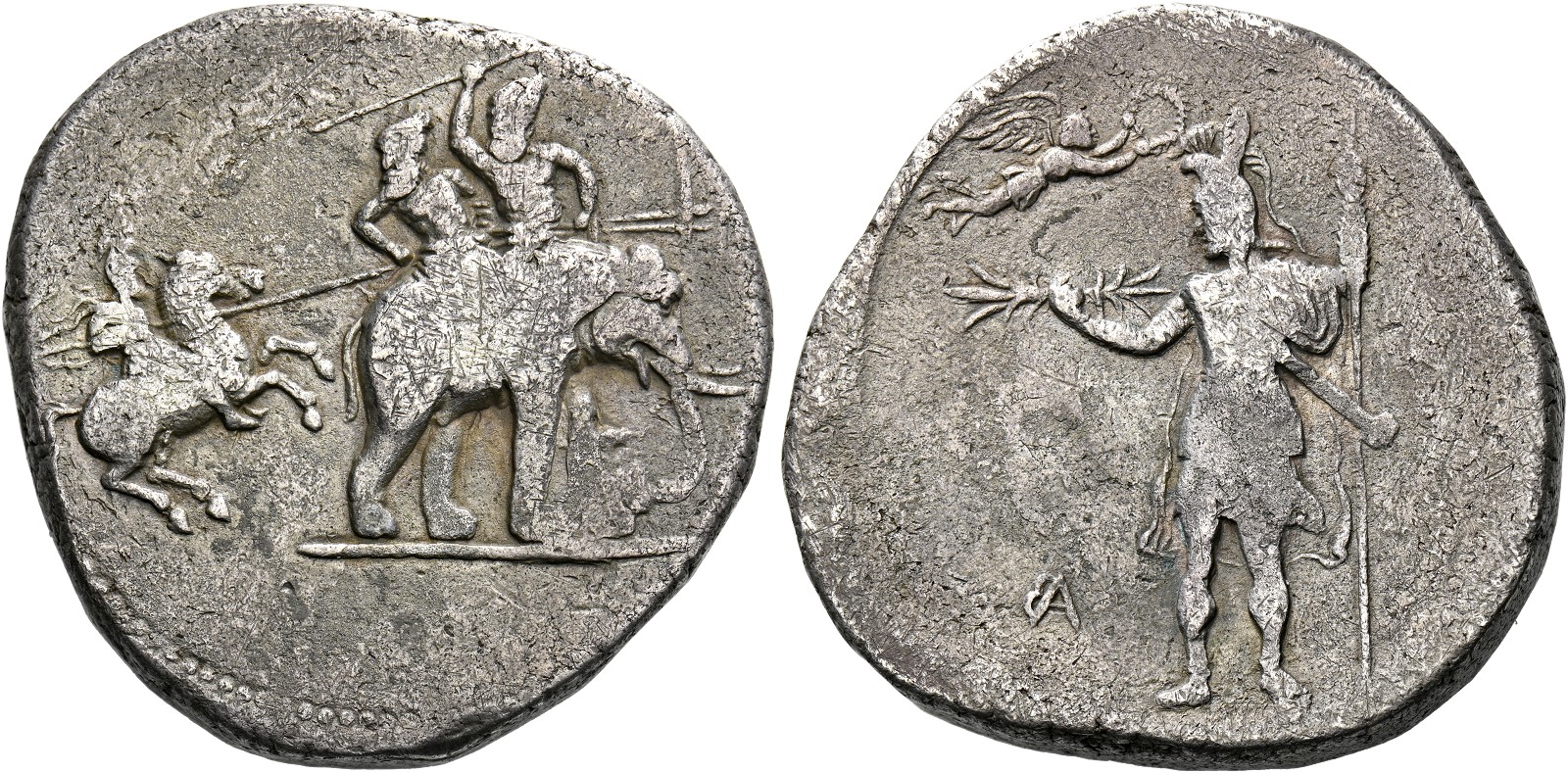S 1778 - Babylon? (Alexander the Great), silver, 5 shekels (Alexander/Porus) (327 BCE)
From SILVER
327 BCE - 327 BCE Silver 1,909 kg
Description
| ObverseInscription or printing placed on the obverse.: | Alexander on Bucephalus facing r., spearing at a mahout and his master seated on an Indian elephant retreating r., the mahout and master look back towards Alexander, the latter grasps the end of Alexander's sarissa with his r. hand, the former brandishes a spear in his r. hand above his head while holding two further spears in his l. hand, above, [Ξ]. |
| ReverseInscription or printing placed on the reverse.: | Alexander standing l. in military attire, wearing plumed Phrygian (?) helmet and holding a thunderbolt in his r. hand and a sarissa in his l., above, Nike flies r. to crown him. In lower l. field AB ligate |
Mint and issuing power
| MintIdentifies the place of manufacture or issue of a numismatic object.: | Babylon | Ancient regionAncient region.: | Mesopotamia | Modern countryModern country: Iraq | AuthorityIdentifies the issuing power. The authority can be "pretended" when the name or the portrait of X is on the coin but he/she was not the issuing power. It can also be "uncertain" when there is no mention of X on the coin but he/she was the issuing power according to the historical sources: | Alexander III the Great (Argead king, 336-323 BC) |
Chronology
| FromIdentifies the initial date in a range assigned in a numismatic context. | 327 BCE | toIdentifies the final date in a range assigned in a numismatic context.. | 327 BCE | PeriodTime period of the numismatic object.: Classical 480-323 BC |
Physical description
| MetalThe physical material (usually metal) from which an object is made.: | Silver |
Median weightMedian of the weights of numismatic objects (in grams). in grams | 43.00 | DenominationTerm indicating the value of a numismatic object. Examples: tetradrachm, chalkous, denarius.: | decadrachm |
StandardStandard.: | Attic |
Image

S1778 Porus decadrachm.jpg [1]
References
| Die study referencePublication of the study: | Price 19821Price 1982, Price 1991b2Price 1991b, Holt 20033Holt 2003, p. 167 | ||
| Coin series referenceReference to coin series study: | |||
Obverse dies distribution
| FrequencyFrequency of specimen in distribution. ᵖ | Number of obversesNumber of obverse dies. ᵖ (o) | % (o) | Number of coinsNumber of coins. (n) | % (n) | Die nameName(s) of the die(s). |
| 1 | 1 | 50 | 1 | 10 | 2 |
| 9 | 1 | 50 | 9 | 90 | 1 |
| Total | 2 of 2 | 100 | 10 of 10 | 100 |
Reverse dies distribution
no distribution is available
Quantification
| Number of obversesNumber of obverse dies. ᵖ (o) | 2 | Number of singletons (o1)The number of singleton coins. ᵖ | 1 |
| Number of reverse diesNumber of reverse dies. (r) | 6 | Number of coinsNumber of coins. (n) | 10 |
| Coins per obverse dieNumber of coins per obverse die. (n/o) | 5 | Coins per reverse dieNumber of coins per reverse die. (n/r) | 1.67 |
| Reverse per obverse ratioRatio of obverse dies divided by reverse dies. (r/o) | 3 | Percentage of singletons (o1)number of coins (n) divided by the number of singletons (o1) ᵖ | 50 % |
| Original number of dies (O) (Carter 1983 formula)The estimation of the number of coins according to Carter 1983 ᵖ | 2.22 | Coins struck if 20,000 as average productivity per dieCoins made if the average productivity for obverses (according to Carter) is 20,000. ᵖ | 44,400 |
| Original number of dies (O) (Esty 2011 formula)The estimation of the number of coins according to the singleton formula in Esty 2011 ᵖ (O) | 2.5 | Survival rate if 20,000 as average productivity per dieSurvival rate if average productivity is 20,000. ᵖ | 0.00023 |
| Coverage (o = % of O) (Esty 1984 formula)Esty 1984 - coverage (% of O) ᵖ (o = % of O) | 90% | Die productivity if survival rate 1/2,000Average productivity if survival rate is 1/2,000. ᵖ | 9,009.01 |
| Weight of silver (in kg) if 20,000 coins per die (O = Carter formula)Carter 1983 * Median weight * 20000 (*10 if gold or electrum) ᵖ | 1,909 kg <br /> 1,909 kg | Die productivity if survival rate 1/5,000Average productivity if survival rate is 1/5,000. ᵖ | 22,522.52 |
Remarks
Most likely one single workstation
References
- ^ Price, Martin J. (1982), "The 'Porus' coinage of Alexander the Great: a symbol of concord and community", in S. Scheers (ed.), Studia Paulo Naster oblata, I, Leuven, p. 75-88, pl. IX-XI
- ^ Price, Martin J. (1991), "Circulation at Babylon in 323 B.C.", in W.E. Metcalf (ed.), Mnemata : papers in memory of Nancy M. Waggoner, New York, p. 63-72, pl. 15-17.
- ^ Holt, Frank L. (2003), Alexander the Great and the Mystery of the Elephant Medallions, Berkeley, xv, 198 p., 5 pl.